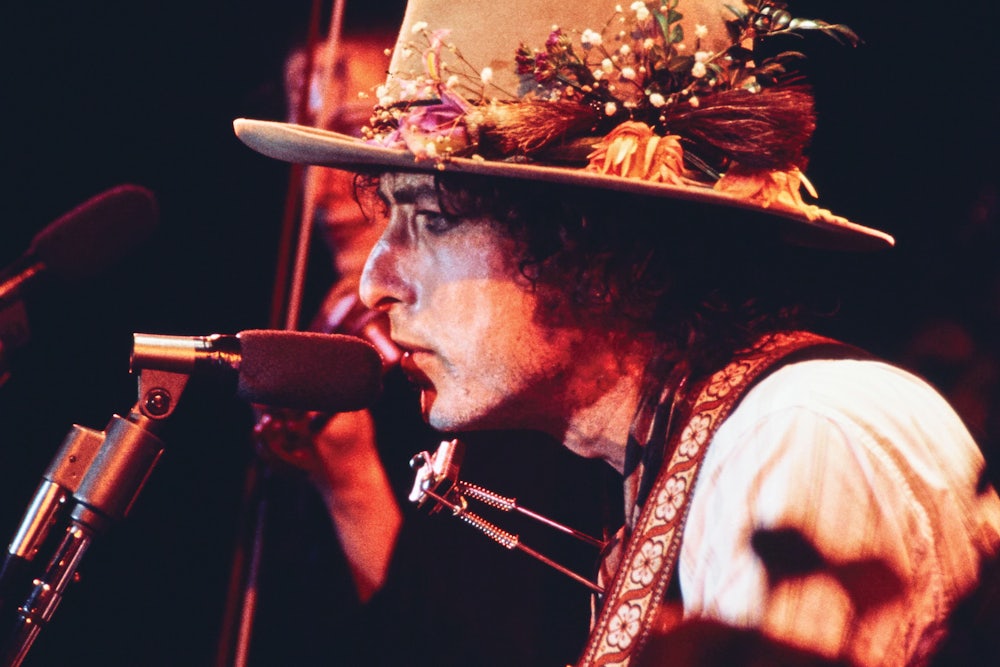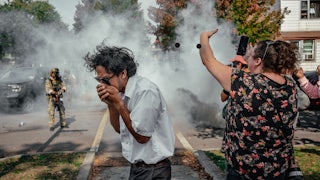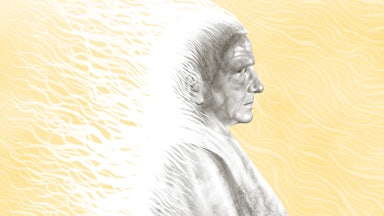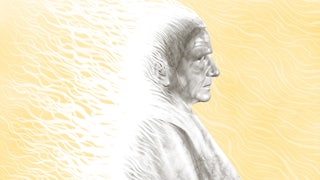At the start of Martin Scorsese’s 2019 documentary Rolling Thunder Revue: A Bob Dylan Story—a film whose opening title card reads conjuring the rolling thunder revue—magician Georges Méliès drapes a blanket over a woman seated on a chair. He pulls the blanket off, and she is no longer there. Then he puts the blanket back on the chair, pulls it off again, and presto, she has reappeared.
The verb “conjure” means to “call upon (a spirit or ghost) to appear, by means of a magic ritual.” The film tracks the first part of a two-part Bob Dylan tour, which covered New England and parts of Canada in the final months of 1975. After Dylan’s motorcycle accident in 1966, he withdrew from touring for eight years, reappearing in public in 1974 on a tour with the Band. The Rolling Thunder Revue was his next venture as a touring artist, and he has regularly toured the world ever since.
The film opens on July 4, 1976, showing a celebration of America’s 200th anniversary of independence. Then Richard Nixon comes on camera, mouthing some bromide about the American dream. Halfway through the film, Nixon reappears as he gives his resignation speech (in 1974), and we watch President Gerald Ford quote Thomas Jefferson: “The people are the only sure reliance for the preservation of our liberty,” then add, “Abraham Lincoln renewed this American article of faith asking, ‘Is there any better way, or equal hope in the world?’” Then we hear the thoughts of the right-wing preacher Billy Graham: “I think it’s time to stand up and say, ‘Well, we believe in these institutions, we believe in America. And I think America ought to sing a bit.’”
The means of transportation for the Rolling Thunder musicians (other performers included Joan Baez, Ramblin’ Jack Elliott, and, later, Joni Mitchell) was a medium-size bus that Dylan apparently often drove himself. As the bus rolls past a visibly decaying mill town, a voice-over—which turns out to be Sam Shepard, who tagged along on the tour and wrote a book about it—explains that New England was “just experiencing the bane of economic fallout way back then.… Desolate, really difficult economic times … People suffering behind that, you know. Rock and roll was, I don’t know, some kind of medicine or something. They certainly weren’t celebrating the birth of America.” It seems that Dylan and his entourage were providing a kind of tonic for despondent audiences. Here is what the chauffeur driving Dylan’s violinist, Scarlet Rivera, observed: “I never paid attention to the response between the audience and the people on the stage.… That to me was like a show all by itself.… It was like one battery charging another.”
One explanation for the title of the Rolling Thunder Revue is that it was supposedly named after the spiritual leader Rolling Thunder. Interviewed on camera, he explains himself thusly: “It’s beautiful music when that thunder rolls. And that’s the way I got my name. I used to scream like a little eagle is what they told me, even when I was a baby in diapers, ran right out in a storm.… And that lightning flash, there’s lots of power in that.”
This was why Dylan thought it made sense to visit and play at the Tuscarora Reservation after he and his entourage performed at Niagara Falls. Ramblin’ Jack recounts: “Bob was seated across the table from me and said, ‘Do you remember Peter [La Farge]’s song about Ira Hayes?’” The film then shows Dylan singing the song from memory for his Iroquois audience. (Ira Hayes was a Pima Indian and U.S. Marine who helped hoist the American flag at Iwo Jima. After the war he struggled with post-traumatic stress disorder and died from hypothermia and alcohol abuse near his home in Arizona.) Mad Bear from the Tuscarora Reservation presents Dylan with a necklace whose beads, he suggests, might just be the same ones Peter Minuit is said to have used to purchase Manhattan Island from the Lenape. But he closes with the following words: “Somewhere along the line, something has failed, and we hope this country can straighten out before too long, because there’s many things that’s going to happen to shape not only this country but the whole world.”
Throughout the movie, Dylan wears white-face paint, a hat with flowers on its left brim, and a scarf, inspired in large part by the nineteenth-century mime Baptiste (portrayed in the legendary 1945 French film Les Enfants du Paradis),
while singing with unusual ferocity. Toward the film’s end, Rubin “Hurricane” Carter—the former middleweight boxer about whom Dylan wrote the eponymous song that helped free Carter from prison, where he was languishing on an apparently trumped-up murder charge—makes a smiling, voluble appearance, describing Dylan as a perennial searcher: “I always ask him, ‘Have you found it yet, Bob?’ And Bob says, ‘Yes, I’ve found it,’ but I know he hasn’t, because he keeps searching.” Dylan responds, “I’d say, ‘Well, Hurricane, I’m searching for the Holy Grail … and I am gonna search until I find it, like Sir Galahad.’”
Dylan’s official Instagram account quoted Scarlet Rivera, who asserted the following: “It was confirmed for me that I was with a living genius, on the level of Shakespeare of our time.” The Argentine writer Jorge Luis Borges imagined Shakespeare, on his deathbed, pleading with God, “I who have been so many men in vain want to be one and myself.” Dylan, like Shakespeare, has adopted many guises, which in his case have taken musical forms with theatrical aspects, some of them very painful for him. Perhaps, as the end nears, Dylan will finally achieve a whole and integrated self. We should hope. God bless.




